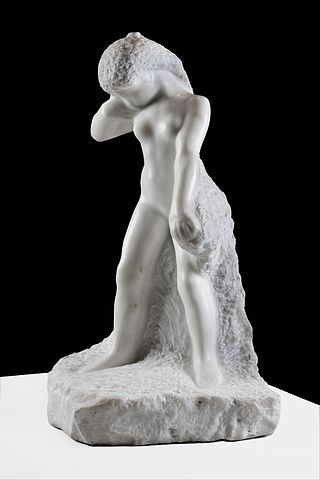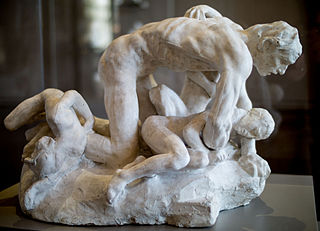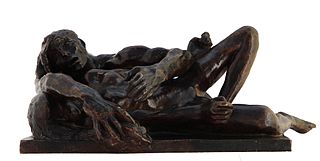
François Auguste René Rodin was a French sculptor generally considered the founder of modern sculpture. He was schooled traditionally and took a craftsman-like approach to his work. Rodin possessed a unique ability to model a complex, turbulent, and deeply pocketed surface in clay. He is known for such sculptures as The Thinker, Monument to Balzac, The Kiss, The Burghers of Calais, and The Gates of Hell.

The Thinker is a bronze sculpture by Auguste Rodin, situated atop a stone pedestal. The work depicts a nude male figure of heroic size sitting on a rock. He is seen leaning over, his right elbow placed on his left thigh, holding the weight of his chin on the back of his right hand. The pose is one of deep thought and contemplation, and the statue is often used as an image to represent philosophy.

The Gates of Hell is a monumental bronze sculptural group work by French artist Auguste Rodin that depicts a scene from the Inferno, the first section of Dante Alighieri's Divine Comedy. It stands at 6 metres high, 4 metres wide and 1 metre deep (19.7×13.1×3.3 ft) and contains 180 figures.

The Martyr or The Little Martyr is a c.1885 plaster sculpture of a naked dead or sleeping female figure by Auguste Rodin, now in the Musee Rodin.

Standing Female Faun or Standing Fauness is a sculpture by Auguste Rodin in 1910. It is sculpted from white marble and its dimensions are 70.1 x 44.7 x 38.4 cm.

Eternal Springtime is a c. 1884 sculpture by the French artist Auguste Rodin, depicting a pair of lovers. It was created at the same time as The Gates of Hell and originally intended to be part of it. One of its rare 19th-century original casts belongs to the permanent collection of Calouste Gulbenkian Museum.

The Falling Man is a sculpture by French artist Auguste Rodin modeled in 1882 and is part of Rodin's emblematic group The Gates of Hell.

Fugitive Love is a sculpture by Auguste Rodin made between 1886 and 1887, both sculpted in marble and cast in bronze. It represents a man and a woman embracing each other on top of a rock. More specifically, the author was inspired by the story of Francesca da Rimini's love affair with Paolo Malatesta, an allusion to Dante Alighieri's depiction of lust on the second circle of Hell in his Inferno.

Ugolino and his sons is a plaster sculpture by French artist Auguste Rodin, part of the sculptural group known as The Gates of Hell. As an independent piece, it was exhibited by its author in Brussels (1887), Edinburgh (1893), Genoa (1896), Florence (1897), Netherlands (1899) and in his own retrospective in 1900.

Avarice and Lust is a sculpture by French artist Auguste Rodin, conceived between 1885 and 1887, representing two of the seven capital sins and is part of his sculptural group The Gates of Hell, where it can be found in the lower part of the right door. It's possible that the name was inspired by Victor Hugo's poem Après une lecture du Dante:

Eve is a nude sculpture by the French artist Auguste Rodin. It shows Eve despairing after the Fall.

The Kneeling Man is a work originally conceived in 1888 by the French artist Auguste Rodin for his The Gates of Hell project.

The Succubus is a bronze sculpture with a green and dark brown patina. It was originally conceived in 1889 by the French artist Auguste Rodin as part of a set of works showing sirens and Nereids. It later formed part of his state-commissioned monument to Victor Hugo. It is now in the Museo Soumaya in Mexico City.

Glaucus is a sculpture by the French artist Auguste Rodin, first conceived in 1886 as a representation of the mythological figure Glaucus, son of Poseidon. Originally made in plaster, bronze casts of it are now in the Brooklyn Museum and the Museo Soumaya.

Youth Triumphant is one of the sculptures created by Auguste Rodin as part of the planning for his The Gates of Hell. It was inspired by Jean Dampt's The Grandmother's Kiss, exhibited in 1893. That work shows a young woman resting in the arms of an old woman, with the pair deeply kissing.

Despair or Despair at the Gate is a sculpture by Auguste Rodin that he conceived and developed from the early 1880s to c. 1890 as part of his The Gates of Hell project. The figure belongs to a company of damned souls found in the nine circles of Hell described by Dante in The Divine Comedy. Other title variations are Shade Holding her Foot, Woman Holding Her Foot, and Desperation. There are numerous versions of this work executed as both plaster and bronze casts and carved marble and limestone.

Ovid's Metamorphoses or The Satyrs is a sculpture by Auguste Rodin, created as part of The Gates of Hell.

Damned Women is a sculpture created by Auguste Rodin between 1885 and 1890 as part of his The Gates of Hell project—it appears on the upper right as the counterpart to The Fallen Caryatid.

Torso of Adele is an 1878-1884 sculpture by the French artist Auguste Rodin, originally modelled in plaster before being worked in terracotta.




















